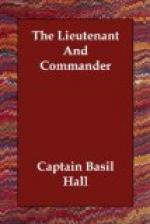I have seen a pilot-boat off New York, in the morning, in a calm, with all her sails set, lying asleep on the water, which had subsided into such perfect stillness that we could count the seam of each cloth in the mirror beneath her, and it became difficult to tell which was the reflected image, which the true vessel. And yet, within a few hours, I have observed the same boat, with only her close-reefed foresail set—no one visible on her decks—and the sea running mountains high, threatening to swallow her up. Nevertheless, the beautiful craft rose as buoyantly on the back of the waves as any duck, and, moreover, glanced along their surface, and kept so good a wind, that, ere long, she shot ahead, and weathered our ship. Before the day was done, she could scarcely be distinguished from the mast-head to windward, though we had been labouring in the interval under every sail we could safely carry.
The balsas of Peru, the catamarans and masullah boats of the Coromandel coast, and the flying proas of the South Sea Islands, have all been described before, and their respective merits dwelt upon, by Cook, Vancouver, Ulloa, and others. Each in its way, and on its proper spot, seems to possess qualities which it is difficult to communicate to vessels similarly constructed at a distance. The boats of each country, indeed, may be said to possess a peculiar language, understood only by the natives of the countries to which they belong; and truly, the manner in which the vessels of some regions behave, under the guidance of their respective masters, seems almost to imply that the boats themselves are gifted with animal intelligence. At all events, their performance never fails to excite the highest professional admiration of those whom experience has rendered familiar with the difficulties to be overcome.




